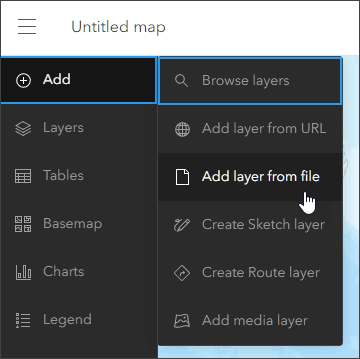In this tip, you will learn how to use Google Drive to add comma-separated values (CSV) files as map layers in ArcGIS Online.
Google Drive is a cloud storage service that enables you to upload, save, and share various types of files to Google servers. Google Drive can serve as a storage solution to free up space on your device, as a backup for your files, or for collaborating with others. Anyone with a Google account has free storage available on Google Drive.
To complete this tip, you will need a CSV file with latitude/longitude coordinates or addresses uploaded to your Google Drive. If you don’t have an appropriate CSV file, you can upload an existing file containing a list of Alaskan volcanoes to your Google Drive.
If you’re signed into your Google account, you can access and add Google Drive files using Add layer from file in Map Viewer. Alternately, you can add Google Drive files using New Item in the Content tab in ArcGIS Online. If the file contains location data, a hosted feature layer can be published, then added to your map. The steps for this approach are similar to the Map Viewer workflow described in this tip.
Add CSV Files in Map Viewer
Step 1: Sign in to your ArcGIS account and open Map Viewer. There are two ways to add Google Drive CSV files as layers from the Contents (dark) toolbar in Map Viewer.
(1) Click Add, then Add layer from file.

(2) From the Layers pane, choose Add layer from file from the Add drop-down menu.

Step 2: In the Add Layers pane, select Google Drive.

Step 3: If needed, select your Google account and sign in. If prompted, allow ArcGIS Online to access your Google account.

Step 4: Select the CSV file you want to add to your map or use Search to find the file you want. The CSV should have latitude/longitude coordinates or addresses to add to your map. Do the following:
(a) If CSV is not already selected in the pulldown menu on the right, select it. Available CSV files are then filtered and presented in a list.
(b) Select the file that contains the data that you want to add to your map.
(c) Click Next when finished.

Step 5: A hosted feature layer will now be created from the CSV file. Select the fields that you want to include, then click Next.

Step : Choose the location fields in the file used to place features on the map. Locations can be:
- Latitude/longitude coordinates
- Military Grid Reference System (MGRS) coordinates
- US National Grid (USNG) coordinates
- Addresses (note: address matching consumes credits)
If the CSV file has no location data, the data will be added as a table.
Click Next to continue.

Step 7: A hosted feature layer will now be created and automatically added to your map. Specify the title, summary, tags, and other information for the hosted feature layer.
When finished, click Create and add to map.

Step 8: Style and configure the layer as you would any other hosted feature layer.
Once a hosted feature layer is created from a Google Drive source, you can update the hosted feature layer from Google Drive by overwriting the entire feature layer if needed. This works best when you are only signed in to a single Google account, typically the one the file was originally accessed from.
To update the feature layer, in the Overview tab on the hosted feature layer item pages, click Update Data.

Then choose Overwrite entire feature layer. Click Sign in and overwrite.

Once you sign in to your Google Drive account, the hosted feature layer will be automatically updated from the Google Drive source. Note that the file name and schema must be the same as the original file used to publish the hosted feature layer.
To add other supported Google Drive files to your map, select the file type from the drop-down menu. Shapefiles and geodatabases can be added as ZIP files. Other supported formats include Excel spreadsheets, GeoJSON, and Google Sheets.
The file will then be scanned to determine its contents. If there is no location data, the file will be added as an item to My Content.
More information
For more information, visit:

